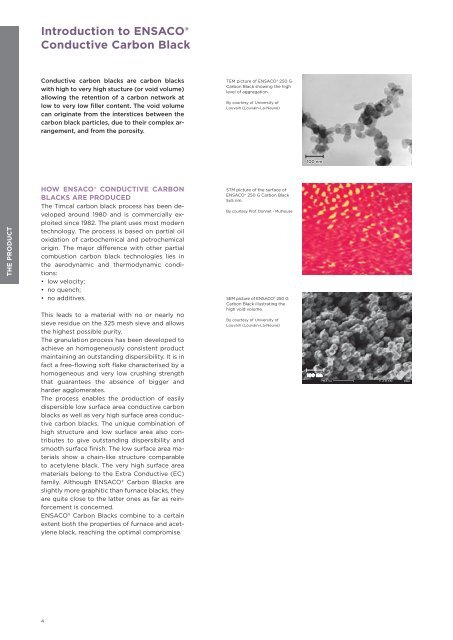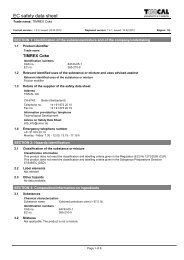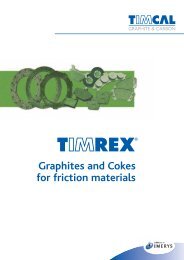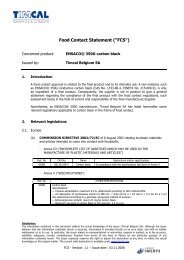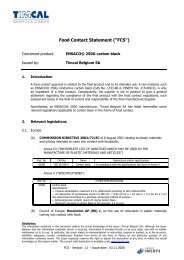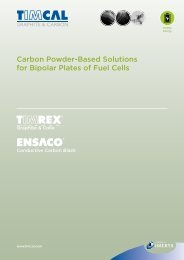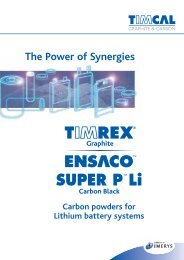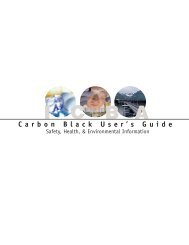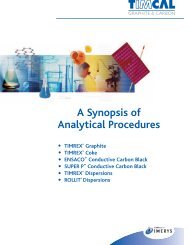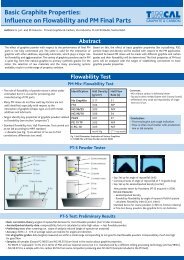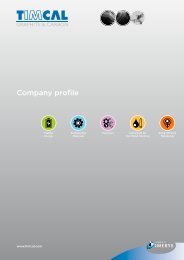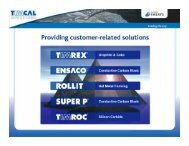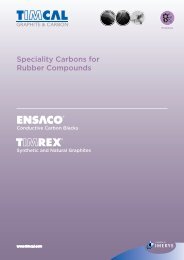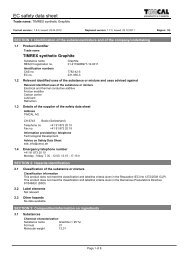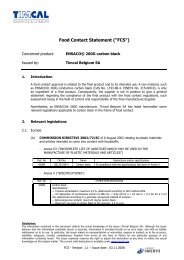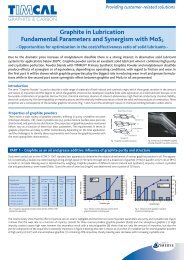Brochure: Carbon Additives for Polymer Compounds - Timcal Graphite
Brochure: Carbon Additives for Polymer Compounds - Timcal Graphite
Brochure: Carbon Additives for Polymer Compounds - Timcal Graphite
Create successful ePaper yourself
Turn your PDF publications into a flip-book with our unique Google optimized e-Paper software.
the product<br />
Introduction to EnSACo®<br />
Conductive <strong>Carbon</strong> Black<br />
Conductive carbon blacks are carbon blacks<br />
with high to very high stucture (or void volume)<br />
allowing the retention of a carbon network at<br />
low to very low filler content. The void volume<br />
can originate from the interstices between the<br />
carbon black particles, due to their complex arrangement,<br />
and from the porosity.<br />
HoW EnSACo® ConduCTIvE CARBon<br />
BLACkS ARE pRoduCEd<br />
The <strong>Timcal</strong> carbon black process has been developed<br />
around 1980 and is commercially exploited<br />
since 1982. The plant uses most modern<br />
technology. The process is based on partial oil<br />
oxidation of carbochemical and petrochemical<br />
origin. The major difference with other partial<br />
combustion carbon black technologies lies in<br />
the aerodynamic and thermodynamic conditions:<br />
• low velocity;<br />
• no quench;<br />
• no additives.<br />
This leads to a material with no or nearly no<br />
sieve residue on the 325 mesh sieve and allows<br />
the highest possible purity.<br />
The granulation process has been developed to<br />
achieve an homogeneously consistent product<br />
maintaining an outstanding dispersibility. It is in<br />
fact a free-flowing soft flake characterised by a<br />
homogeneous and very low crushing strength<br />
that guarantees the absence of bigger and<br />
harder agglomerates.<br />
The process enables the production of easily<br />
dispersible low surface area conductive carbon<br />
blacks as well as very high surface area conductive<br />
carbon blacks. The unique combination of<br />
high structure and low surface area also contributes<br />
to give outstanding dispersibility and<br />
smooth surface finish. The low surface area materials<br />
show a chain-like structure comparable<br />
to acetylene black. The very high surface area<br />
materials belong to the Extra Conductive (EC)<br />
family. Although ENSACO® <strong>Carbon</strong> Blacks are<br />
slightly more graphitic than furnace blacks, they<br />
are quite close to the latter ones as far as rein<strong>for</strong>cement<br />
is concerned.<br />
ENSACO® <strong>Carbon</strong> Blacks combine to a certain<br />
extent both the properties of furnace and acetylene<br />
black, reaching the optimal compromise.<br />
4<br />
TEM picture of ENSACO® 250 G<br />
<strong>Carbon</strong> Black showing the high<br />
level of aggregation.<br />
By courtesy of University of<br />
Louvain (Louvain-La-Neuve)<br />
STM picture of the surface of<br />
ENSACO® 250 G <strong>Carbon</strong> Black<br />
5x5 nm.<br />
By courtesy Prof. Donnet - Mulhouse<br />
SEM picture of ENSACO® 250 G<br />
<strong>Carbon</strong> Black illustrating the<br />
high void volume.<br />
By courtesy of University of<br />
Louvain (Louvain-La-Neuve)<br />
100 nm<br />
100 nm


